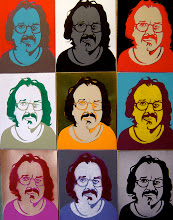
Thursday, August 4, 2010
San Simón, a.k.a. Maximón, has made an appearance. I was sort of expecting him to show up in this painting. So far he’s only an outline, but once he has a foot in the door, you can expect him to manifest himself in a more solid form.
Mam was the most beautiful man in the village. All the young women wanted him in their beds, feeling sure he would be more pleasing than their boyfriends or husbands. Those who let their curiosity get the better of them were not disappointed. All the old women thought he’d be a perfect son, more attentive than the ones they had raised. In fact Mam did go out of his way to do favors for the grandmothers. Rather than see one go hungry, he would spend half a day fishing for her and share the soup she made, sitting with her by her fire and asking her for stories of days gone by. He thatched many a roof to keep an elder dry.
Among the men he was also popular and respected.
How sad then that when the Spanish came ashore and the misunderstanding occurred about whom would bow down to whom, Mam was the first to die.
When the villagers heard the explosion from the arquebus and saw the top of Mam’s head disappear in a spray of blood and bone and brain, they didn’t wait around to see what would happen next. They grabbed his body and faded away into the jungle.
By evening, the people were miles down the coast. They laid Mam on a pyre and the priest set it on fire. All the women gathered around and sobbed. Quite a few men did, too. The tears quenched the flames and flowed over Mam’s body. He was wet and glistening with the tears of everyone who loved and respected him. Cry as they might, they could not bring him back to life. But, he was transformed. His body was changed from ephemeral flesh to one made out of clay, wood, bone, shell, and coral. As beautiful as ever, he became a muñeco that could stay with the villagers forever.
Since he was neither dead nor alive, neither fully on earth nor in the afterlife, not quite human, but certainly not a god, he became a go between, an intermediary. He couldn’t move so he was a good listener. If you came to Mam, spoke to him of your troubles or concerns, lit a candle so he wouldn’t have to sit in the dark, left him some whiskey, blew some smoke in his face, placed something sweet on his tongue, he would plead your case to the ones in charge on a higher plain. More times than not you’d find your situation improved.
Years went by, then decades, then a century or two. Most of the people who were there before the Spanish arrived died of small pox. The Catholic Priests didn’t like the people attending to Mam. They didn’t even like them referring to him, so the people started saying “San Simón” when they wanted to talk about him. For reasons that no one can remember they also started calling him Maximón. Regardless of what he was called, he went right on listening to peoples’ troubles, accepting their offerings, and doing what he could to lighten their load.
With San Simón, a.k.a. Maximón, you didn't need to be ashamed of your foibles. Nor did you need to be laid low by them. If you had a tendency to drink too much, get high too often, share your body too indiscriminately, suffer too much from love gone wrong, you could just turn it over to this beautiful, old muñeco and proceed unencumbered by regret or guilt.
As his body wore out, the people refurbished it. Eventually, he had more than one body and he lived in several locations.
Once in about 1963, a gringita with long, straight, black hair visited him at his house in Guatemala near the lake. She was sad because her husband had recently died in a motorcycle accident. She was a little drunk and a little stoned. She blew marijuana smoke in his face and sang him a song.
Oh but if somehow
you could pack up your sorrows
and give them all to me
You would lose them
I know how to use them
give them all to me
“Yeah”, he thought. “If I had a theme song that would be it.”
It took some time, but things got better for the young woman after that.
I'll write more about San Simón as he comes into focus.

No comments:
Post a Comment